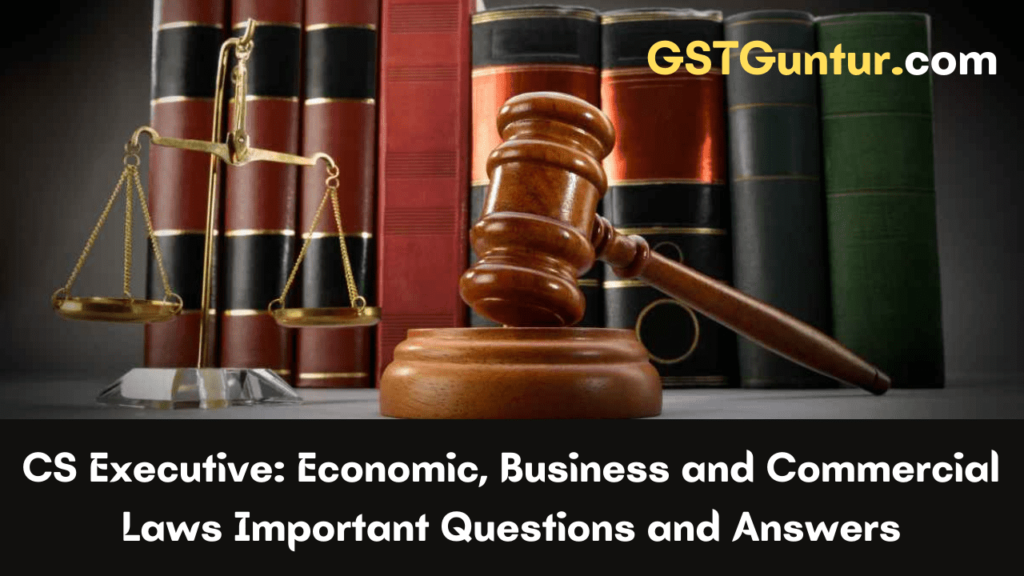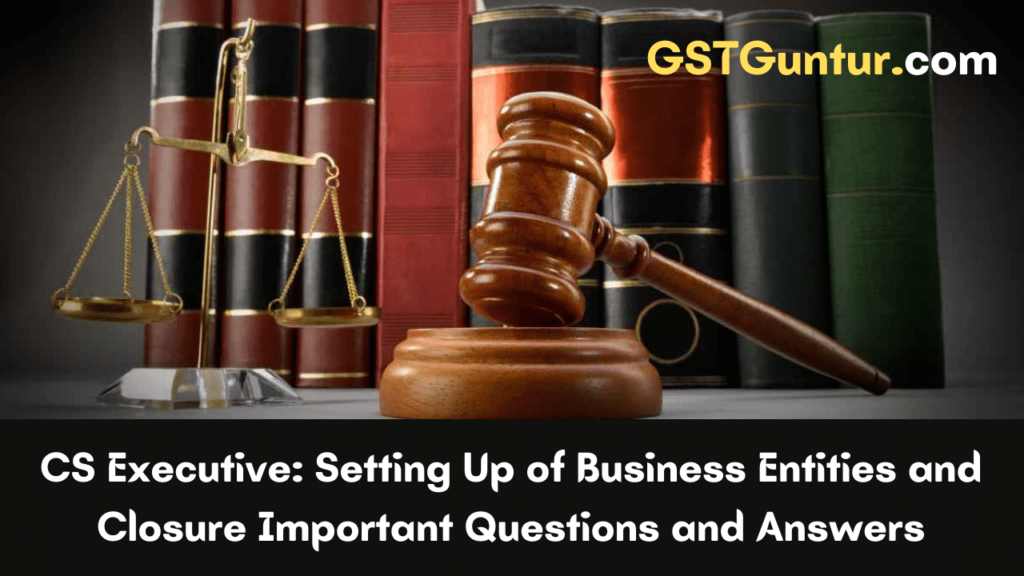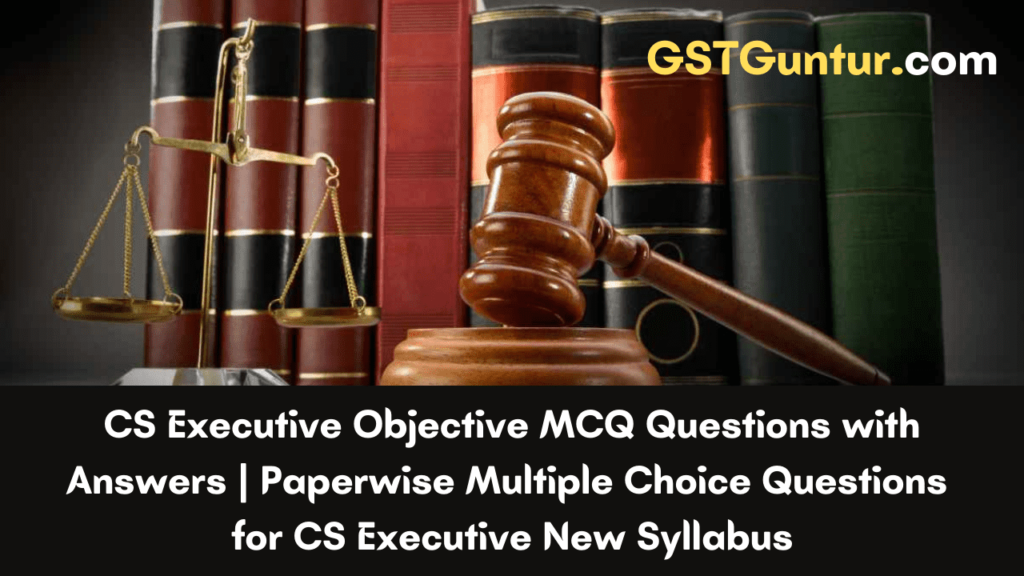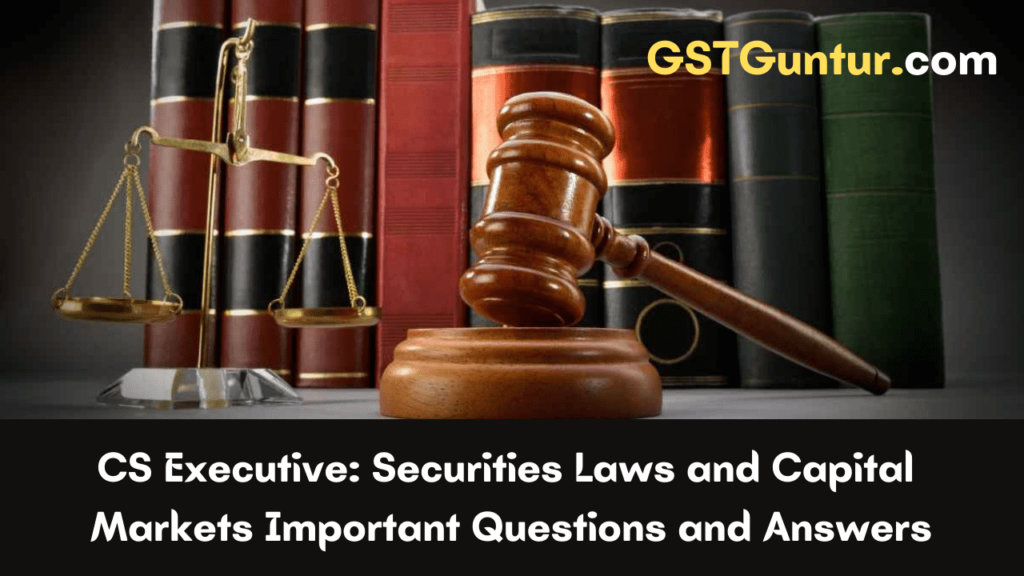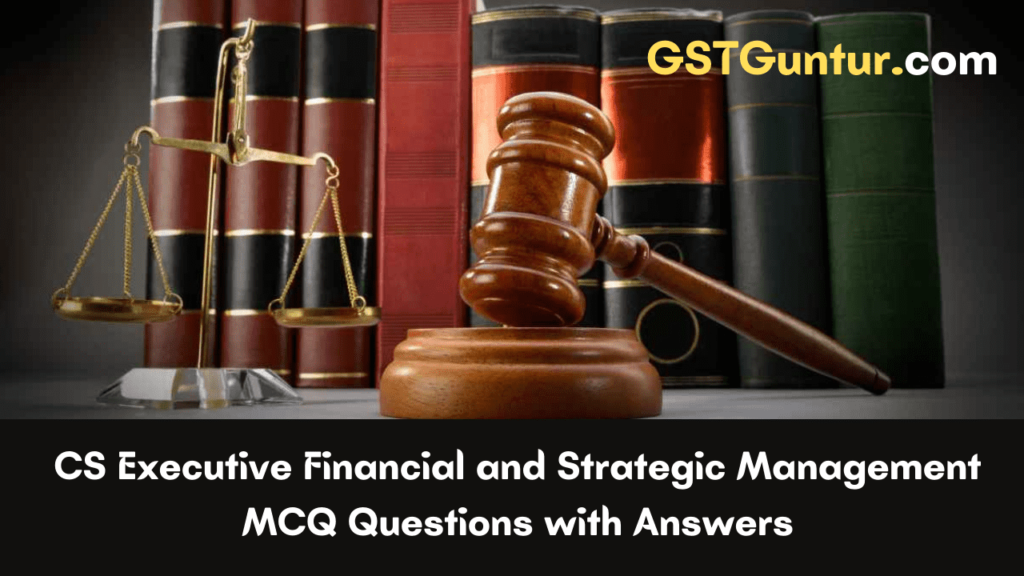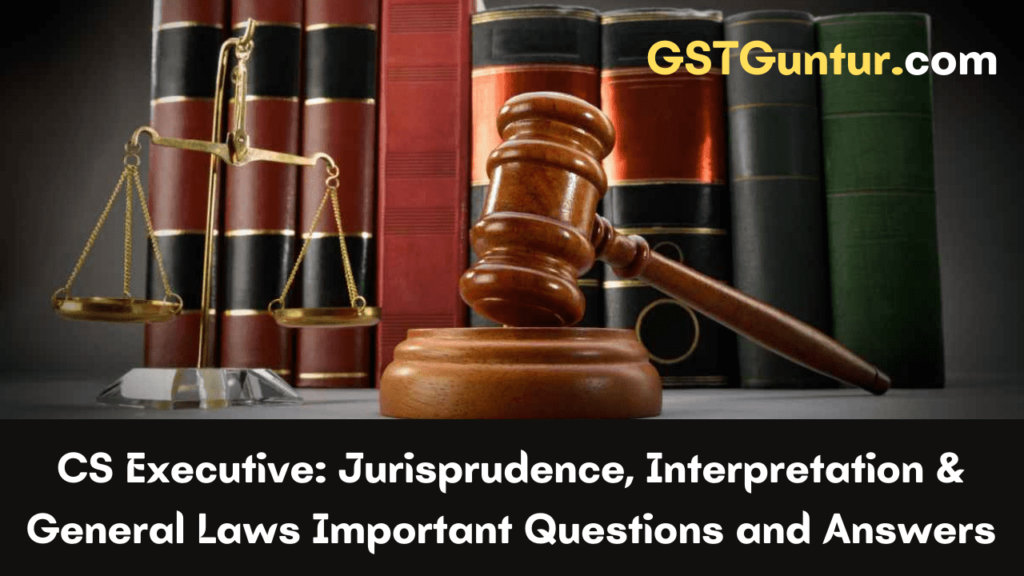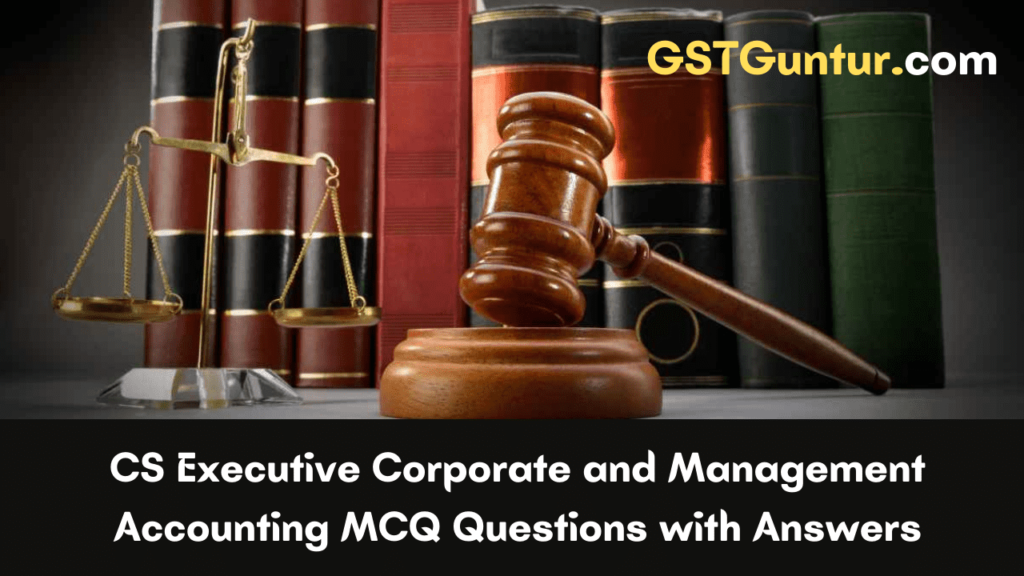Introduction to Cost and Management Accounting – CA Inter Costing Study Material
Introduction to Cost and Management Accounting – CA Inter Costing Study Material is designed strictly as per the latest syllabus and exam pattern.
Introduction to Cost and Management Accounting – CA Inter Costing Study Material
Question 1.
What is Cost Accounting? Enumerate its important objectives. [CA Inter May 2016, May 2010, May 2008, Nov. 2002, May 2001, 3 Marks]
Answer:
Cost Accounting is defined as “the process of accounting for cost which begins with the recording of income and expenditure or the bases on which they are calculated and ends with the preparation of periodical statements and reports for ascertaining and controlling costs.”
The main objectives of the cost accounting are as follows:
(i) Ascertainment of Cost: The main objective of Cost Accounting is accumulation and ascertainment of cost. Costs are accumulated, assigned and ascertained for each cost object which may be a unit, job, operation, process, department or service.
(ii) Determination of Selling Price and Profitability: The cost accounting system helps in determination of selling price and thus profitability of a cost object. Cost accounting system provides a basis for price fixation and rate negotiation.
(iii) Cost Control: It ensures that expenditures are in consonance with pre-determined set standard and any variation from these set standards is noted and reported on continuous basis. To exercise control over cost, following steps are followed:
- Determination of pre-determined standard or results.
- Measurement of actual performance.
- Comparison of actual performance with set standard or target.
- Analysis of variance and action.
(iv) Cost Reduction: It may be defined “as the achievement of real and permanent reduction in the unit cost of goods manufactured or services rendered without impairing their suitability for the use intended or diminution in the quality of the product.”
(v) Assisting management in decision making: Cost and Management Accounting by providing relevant information, assist management in planning, implementing, measuring, controlling and evaluating of various activities. A robust cost and management accounting system provides internal and external information to the industry which will be relevant for decision making.
![]()
Question 2.
Distinguish between Cost Control and Cost Reduction [CA Inter Dec. 2021j May 2019, May 2016, May 2014, Nov. 2011, 5 Marks]
Answer:
Difference between Cost Control and Cost Reduction.
| Cost Control | Cost Reduction |
| Cost Control aims at maintaining the costs as per the established standards. | Cost Reduction is concerned with reducing costs by challenging the standards and endeavours to improvise them continuously. |
| It seeks to attain lowest possible cost under existing conditions. | It recognises no condition as permanent, since a change will result in lower cost. |
| Emphasis is on past and present | Emphasis is on present and future. |
| It is a preventive function | It is a corrective function which operates even when an efficient cost control system exists. |
| It ends when targets are achieved. | It has no visible end and is a continuous process. |
Question 3.
State the difference between Cost Accounting and Management Accounting. [CA Inter Nov. 2020, May 2011, 4 Marks]
Answer:
Difference between Cost Accounting and Management Accounting
| Basis | Cost Accounting | Management Accounting |
| Nature | It records the quantitative aspect only | It records both qualitative and quantitative aspect. |
| Objective | It records the cost of producing a product and providing a service | It prorides information to management for planning and co-ordination |
| Area | It only deals with cost ascertainment. | It is wider in scope as it includes F.A., budgeting, Tax, Planning. |
| Recording of data | It uses both past and present figures. | It is focused with the projection of figures for future. |
| Development | It’s development is related to industrial revolution. | It develops in accordance to the need of modern business world. |
| Rules and Regulations | It follows certain principles and procedures for recording costs of different products | It does not follow any specific rules and regulations. |
Question 4.
State the difference between Financial Accounting and Cost Accounting. [ICAl Module]
Answer:
Difference between Financial Accounting and Cost Accounting
| Basis | Financial Accounting | Cost Accounting |
| Objective | It provides information about the financial performance of an entity. | Ascertainment of cost for the purpose of cost control and decision-making. |
| Recording of data | It records Historical data. | It makes use of both historical and pre-determined costs. |
| Users of information | The users of financial accounting statements are shareholders, creditors, finance analysts, government and its agencies, etc. | The cost accounting information is generally used by internal management. But sometimes regulatory authorities also. |
| Analysis of cost and profit | It shows profit or loss of the organization either segment wise or as a whole. | It provides the cost details for each cost object ie. product, process, job, operation, contracts, etc. |
| Time period | Financial Statements are prepared usually for a year. | Reports and statements are prepared as and when required. |
| Presentation of information | A set format is used for presenting financial information. | In general, no set formats for presenting cost information is followed. |
Question 5.
Why Cost and Management Accounting information are required by the staff at operational level? Describe. [CA Inter May 2018, 5 Marks]
Answer:
The operational level staffs like supervisors, foreman, team leaders are requiring Cost and Management Accounting information:
- to know the objectives and performance goals for them.
- to know product and service specifications like volume, quality and process, etc.,
- to know the performance parameters against which their performance is measured and evaluated,
- to know divisional (responsibility centre) profitability etc.
Question 6.
Describe the uses of Cost and Management Accounting information by the managers. [ICAl Module]
Answer:
The managers use the information:
- to know the cost of a cost object and cost centre,
- to know the price for the product or service,
- to measure and evaluate performance of responsibility centres,
- to know the profitability-product-wise, department-wise, customer-wise etc.,
- to evaluate the strategic options and to make decisions
Question 7.
Briefly explain the essential features of a good cost accounting system. [CA Inter Nov. 2012, Nov. 2005, May 2004, 4 Marks]
Answer:
Essential features of a good cost accounting system are as follows:
(a) Informative and simple: Cost accounting system should be tailor-made, practical, simple and capable of meeting the requirements of a business concern.
(b) Accurate and authentic: The data to be used by the cost accounting system should be accurate and authenticated; otherwise it may distort the output of the system and a wrong decision may be taken.
(c) Uniformity and consistency: There should be uniformity and consistency in classification, treatment and reporting of cost data and related information. This is required for benchmarking and comparability of the results of the system for both horizontal and vertical analysis.
(d) Integrated and inclusive: The cost accounting system should be integrated with other systems like financial accounting, taxation, statistics and operational research etc. to have a complete overview and clarity in results.
(e) Flexible and adaptive: The cost accounting system should be flexible enough to make necessary amendment and modifications in the system to incorporate changes in technological, reporting, regulatory and other requirements.
(f) Trust on the system: Management should have trust on the system and its output. For this, an active role of management is required for the development of such a system that reflects a strong conviction in using information for decision making.
![]()
Question 8.
What are the essential factors for installing a cost accounting system? Explain. [CA Inter May 2017, Nov. 2010, 4 Marks]
Answer:
Before setting up a system of cost accounting, the following factors should be studied:
(i) Objective: The objective of costing system, for example whether it is being introduced for fixing prices or for establishing a system of cost control.
(ii) Nature of Business or Industry: The industry in which the business is operating. Every business or industry has its own uniqueness and objectives. According to its cost information requirement, cost accounting methods are followed. For example, an oil refinery maintains process wise cost accounts to find out the cost incurred on a particular process, say in crude refinement process etc.
(iii) Organisational Hierarchy: Costing system should fulfil the information requirements of different levels of management. Top management is concerned with the corporate strategy, strategic level management is concerned with marketing strategy, product diversification, product pricing etc. Operational level management needs the information on standard quantity to be consumed, report on idle time etc.
(iv) Knowing the product: Nature of the product determines the type of costing system to be implemented. The product which has by-products requires costing system which accounts for by-products as well. In case of perishable or short self- life products, marginal costing is appropriate to know7 the contribution and minimum price at which products could be sold.
(v) Knowing the production process: A good costing system can never be established without the complete knowledge of the production process. Cost apportionment can be done on the most appropriate and scientific basis if a cost accountant can identify degree of effort or resources consumed in a particular process. This also includes some basic technical know-how and process peculiarity.
(vi) Inf ormation synchronisation: Establishment of a department or a system requires substantial amount of organisational resources. While drafting a costing system, information needs of various other departments should be taken into account. For example, in a typical business organisation accounts department needs to submit monthly stock statement to its lender bank, quantity wise stock details at the time of filing returns to tax authorities etc.
(vii) Method of maintenance of cost records: The organisation must determine beforehand the manner in which Cost and Financial accounts could be inter-locked into a single integral accounting system and how the results of separate sets of accounts ie. cost and financial, could be reconciled by means of control accounts.
(viii) Statutory compliances and audit: Records are to be maintained to comply with statutory requirements and applicable cost accounting standards should be followed.
(ix) Information Attributes: Information generated from the Costing system should possess all the attributes of useful information ie. it should be complete, accurate, timely, relevant to have an effective management information system (MIS).
Question 9.
Give any five examples of the impact of use of Information Technology in Cost Accounting. [CA Inter January 2021, 5 Marks]
Answer:
Example of Impact of Information Technology in cost accounting may include the following:
(i) After the introduction of ERPs, different functional activities get inte-grated and as a consequence a single entry into the accounting system provides custom made reports and saves an organisation from preparing different sets of documents.
(ii) A move towards paperless environment can be seen in which the related department can get the e-copy of documents like Bill of Material, Material Requisition Note, Goods Received Note, labour utilisation report etc.
(iii) Information Technology with the help of internet (including intranet and extranet) helping in resource procurement and mobilisation. For example, production department can get materials from the stores without issuing material requisition note physically. Similarly, purchase orders can be initiated to the suppliers with the help of extranet. This enables an entity to shift towards Just-in-Time (JiT) approach of inventory management and production.
(iv) Cost information for a cost centre or cost object is ascertained with accuracy in timely manner. Each cost centre and cost object is codified and all related costs are assigned to the cost objects or cost centres using assigned codes.
(v) Uniformity in preparation of report, budgets and standards can be achieved with the help of IT. ERP software plays an important role in bringing uniformity irrespective of location, currency, language and regulations.
(vi) Cost and revenue variance reports are generated in real time basis which enables the management to take control measures immediately.
(vii) IT enables an entity to monitor and analyse each process of manufacturing or service activity closely to eliminate non-value added activities.
Question 10.
Define cost object and give three examples. [CA Inter May 2000, 2 Marks]
Answer:
Cost object is anything for which a separate measurement of cost is re-quired. Cost object may be a product, a service, a project, a customer, a brand category, an activity, a department or a programme etc.
Examples:
- Product: Smart phone, Tablet computer, SUV Car, Book etc.
- Project: Metro Rail project, Road projects etc.
- Activity: Quality inspection of materials, Placing of orders etc.
Question 11.
Cost of a product or service is required to be expressed in suitable cost unit. State the cost units for the following industries:
(i) Steel
(ii) Automobile
(iii) Transport
(iv) Power
(v) Hotel
(vi) Hospital [CA Inter May 2014, May 2013, 6 Marks]
Answer:
| Industry | Cost Unit |
| (i) Steel | Tonne |
| (ii) Automobile | Numbers |
| (iii) Transport | Passenger km/Tonne km |
| (iv) Power | Kilowatt hour (Kwh) |
| (v) Hotel | Per room day/ or per meal |
| (vi) Hospital Tonne | Per patient day/ or per bed/day |
![]()
Question 12.
Mention the Cost Unit of the following Industries;
1. Electricity
2. Automobile
3. Cement
4. Steel
6. Brick Making
7. Coal Mining
8. Engineering
9. Professional Services
10. Hospital [CA Inter Nov. 2019, 5 Marks]
Answer:
| Industry | Cost Unit Basis |
| (1) Electricity | Kilowatt-hour (kwh) |
| (2) Automobile | Number |
| (3) Cement | Ton/per bag etc. |
| (4) Steel | Ton |
| (5). Gas ‘ | Cubic feet |
| (6) Brick-making | 1,000 bricks |
| (7) Coal mining | Tonne/ton |
| (8) Engineering | Contract, job |
| (9) Professional services | Chargeable hour, job, contract |
| (10) Hospitals | Patient day |
Question 13.
Mention and explain types of responsibility centres. [CA Inter Nov. 2018, 5 Marks]
Answer:
There are 4 types of responsibility centres:
(i) Cost Centres: The responsibility centre which is held accountable for incurrence of costs which are under its control. The performance of this responsibility centre is measured against pre-determined standards or budgets. The cost centres are of two types, viz., Standard Cost Centre and Discretionary Cost Centre.
(ii) Revenue Centres: The responsibility centres which are accountable for generation of revenue for the entity. For example, sales department which is the responsible for achievement of sales target and revenue generation. Though, revenue centres does not have control on the all expenditures it incurs but some time expenditures related with selling activities like commission to sales person etc. are incurred by revenue centres.
(iii) Profit Centres: These are the responsibility centres which have both responsibility of generation of revenue and incurrence of expenditures. Since, managers of profit centres are accountable for both costs as well as revenue, profitability is the basis for measurement of performance of these responsibility centres. Examples of profit centres are decentralised branches of an organisation.
(iv) Investment Centres: These are the responsibility centres which are not only responsible for profitability but also has the authority to make capital investment decisions. The performance of these responsibility centres is measured based on Return on Investment (Rol) besides profit.
Question 14.
Specify the types of Responsibility centres under the following situations: [CA Inter July 2021, 5 Marks]
(i) Purchase of bonds, stocks or real estate property.
(ii) Ticket counter in a Railway station. .
(iii) Decentralized branches of an organisation.
(iv) Maharatna, Navratna and Miniratna public sector undertaking (PSU) of Central Government.
(v) Sales Department of an organisation.
Answer:
(i) Investment Centre
(ii) Revenue Centre
(iii) Profit Centre
(iv) Investment Centre
(v) Revenue Centre
Question 15.
What is meant by “Cost Centre”? What are the different types of cost centres? [CA Inter Nov. 2016, May 2015, Nov. 2002, 4 Marks]
Answer:
Cost Centre: It is the responsibility centre which is held accountable for incurrence of costs which are under its control. The performance of this responsibility centre is measured against pre-determined standards or budgets.
The cost centres are of two types:
(a) Standard Cost Centre: It is the cost centre where output is measurable and input required for the output can be specified. An estimate of standard units of input to produce a unit of output is set and the actual cost for inputs is compared with the standard cost. Any deviation (variance) in cost is measured and analysed into controllable and uncontrollable cost. The manager of the cost centre is expected to comply with the standard and held responsible for adverse cost variances. The input-output ratio for a standard cost centre is clearly identifiable.
(b) Discretionary Cost Centre: The cost centre whose output cannot be measured in financial terms, thus input-output ratio cannot be defined. The cost of input is compared with allocated budget for the activity. Examples are Research & Development department, Advertisement department.
Question 16.
What do you mean by ‘Profit Centre’? [CA Inter May 2016, 2 Marks]
Answer:
Profit Centre is the responsibility centre which has both responsibility of generation of revenue and incurrence of expenditures. Since, managers of profit centres, are accountable for both costs as well as revenue, profitability is the basis for measurement of performance of these responsibility centres. Examples are decentralised branches of an organisation.
Question 17.
Distinguish between Profit Centres and Investment Centres. [CA Inter May 2006, 2 Marks]
Answer:
Profit centres are the responsibility centres which have both responsibility of generation of revenue and incurrence of expenditures. Profitability is the basis for measurement of performance of these responsibility centres. Investment centres are the responsibility centres which are not only responsible for profitability but also have the authority to make capital investment decisions. The performance of these responsibility centres are measured on the basis of Return on Investment (Rol) besides profit.
Question 18.
Distinguish between cost units and cost centres. [CA Inter May 2011, 4 Marks]
Answer:
Cost units: It is a unit of product, service or time (or combination of these) in relation to which costs may be ascertained or expressed. A batch which consists of a group of identical items and maintain its identity through one or more stages of production may also be considered as a cost unit. Cost units are usually the units of physical measurement like number, weight, area, volume, length, time and value.
Cost centre: It is the responsibility centre which is held accountable for incur-rence of costs which are under its control. The performance of this responsi-bility centre is measured against pre-determined standards or budgets. The cost centres are of two types, viz, Standard Cost Centre and Discretionary Cost Centre.
Question 19.
State the limitations of cost accounting. [ICAI Module]
Answer:
The limitations of cost accounting are as follows:
1. Expensive: It is expensive because analysis, allocation and absorption of overheads requires considerable amount of additional work, and hence additional money.
2. Requirement of reconciliation: The results shown by cost accounts differ from those shown by financial accounts. Thus preparation of reconciliation statements is necessary to verify their accuracy. ;
3. Duplication of work: It involves duplication of work as organisation has to ; maintain two sets of accounts ie. Financial Accounts and Cost Accounts.
![]()
Question 20.
Discuss cost classification based on variability and controllability. [CA Inter May 2018, May 2008, Nov. 2006, Nov. 2004, May 2003, Nov. 2001, May 2001, 4 Marks]
Answer:
Cost classification based on variability
- Fixed cost : These are the costs which are incurred for a period, and which, within certain output and turnover limits, tend to be unaffected by fluctuations in the levels of activity (output or turnover). They do not tend to increase or decrease with the changes in output. For example, rent, insurance of factory building etc.
- Variable costs: These costs tend to vary with the volume of activity. Any increase in the activity results in an increase in the variable cost and vice versa. For example, direct material cost, direct labour cost, etc.
- Semi-variable costs: These costs contain both fixed and variable components and are thus partly affected by fluctuations in the level of activity. For example, telephone bill, gas and electricity etc. Cost classification based on controllability
- Controllable costs: Cost that can be controlled, typically by a cost, profit or investment centre manager is called controllable cost. Controllable costs incurred in a particular responsibility centre can be influenced by the action of the manager heading that responsibility centre e.g., direct costs.
- Uncontrollable costs: Costs which cannot be influenced by the action of a specified member of an undertaking are known as uncontrollable costs. For example, expenditure incurred by the tool room is controllable by the foreman in-charge of that section but the share of the tool-room i expenditure which is apportioned to a machine shop is not controlled by the machine shop foreman.
Question 21.
Explain the following:
1. Explicit costs
2. Implicit costs [CA Inter May 2014, May 2005, May 2001, 2 Marks]
Answer:
Explicit costs: These costs are also known as out-of-pocket costs and refer to costs involving immediate payment of cash. Salaries, wages, postage and telegram, printing and stationery, interest on loan etc. are some examples of explicit costs involving immediate cash payment.
Implicit costs: These costs do not involve any immediate cash payment. They are not recorded in the books of account. They are also known as economic costs.
Question 22.
Explain:
(i) Product cost [CA Inter Nov. 2016, May 2003, 2 Marks]
(ii) Sunk cost [CA Inter Nov, 2016, May 2003, 2 Marks]
(iii) Opportunity Cost [CA Inter May 2018, Nov. 2016, May 2003, 2 Marks]
Answer:
(i) Product Cost: These are the costs which are associated with the pur! chase and sale of goods (in the case of merchandise inventory). In the production scenario, such costs are associated with the acquisition and conversion of materials and all other manufacturing inputs into finished product for sale. Hence, under marginal costing, variable manufacturing costs and under absorption costing, total manufacturing costs (variable and fixed) constitute inventoriable or product costs.
(ii) Sunk cost: Historical costs incurred in the past are known as sunk costs, They play no role in decision making in the current period. For example, in case of decision relating to the replacement of a machine, the WDV, of the existing machine is a sunk cost and therefore, not considered,
(iii) Opportunity Cost: This cost refers to the value of sacrifice made or benefit of opportunity foregone in accepting an alternative course of action. For example, a firm financing its expansion plan by withdrawing money from its bank deposits. In such a case the loss of interest on the bank deposit is the opportunity cost for carrying out the expansion plan.
Question 23.
Define the following:
(a) Imputed Cost
(b) Capitalised cost [CA Inter Nov. 2009, 2 Marks]
Answer:
(a) Imputed Cost: Imputed costs are notional costs which do not involve any cash outlay. For example, interest on capital, the payment for which is not actually made. These costs are similar to opportunity costs.
(b) Capitalised Cost: Capitalised Costs are costs which are initially recorded as assets and subsequently treated as expenses. Example, installation expenses on the erection of a machine are added to the cost of a machine.
Question 24.
Explain the following:
1. Out-of-pocket cost
2. Shut down costs
3. Discretionary costs
4. Engineered costs [ICAI Module]
Answer:
1. Out-of-pocket Cost: It is that portion of total cost, which involves cash outflow. It can be used in decisions relating to fixation of selling price in recession, make or buy, etc. Out-of-pocket costs can be avoided or saved if a particular proposal under consideration is not accepted.
2. Shut down Costs: Those costs, which continue to be, incurred even when a plant is temporarily shut-down e.g. rent, rates, depreciation, etc. These costs cannot be eliminated with the closure of the plant.
3. Discretionary Costs: Such costs are not tied to a clear cause and effect relationship between inputs and outputs. They usually arise from periodic decisions regarding the maximum outlay to be incurred. Examples include advertising, public relations, executive training etc.
4. Engineered Costs: These are costs that result specifically from a clear cause and effect relationship between inputs and outputs. The relationship is usually personally observable. Examples of inputs are direct material costs, direct labour costs etc. Examples of output are cars, computers etc.
![]()
Question 25.
Distinguish between product cost and period cost. [CA Inter June 2009, May 2006, 2 Marks]
Answer:
Product costs are associated with the purchase and sale of goods. In the production scenario, such costs are associated with the acquisition and conversion of materials and all other manufacturing inputs into finished product for sale. Hence under marginal costing, variable manufacturing costs and under absorption costing, total manufacturing costs (variable or fixed) constitute inventoriable or product costs.
Period costs are the costs, which are not assigned to the products but are charged as expense against revenue of the period in which they are incurred. All non-manufacturing costs such as general & administrative expenses, selling and distribution expenses are recognised as period costs.
Question 26.
State the types of cost in the following cases:
(i) Interest paid on own capital not involving any cash outflow.
(ii) Withdrawing money from bank deposit for the purpose of purchasing new machine for expansion purpose.
(iii) Rent paid for the factory building which is temporarily closed.
(iv) Cost associated with the acquisition and conversion of material into finished product. [CA Inter May 2012, 4 Marks]
Answer:
(i) Imputed Cost
(ii) Opportunity cost
(iii) Shutdown cost
(iv) Product cost
Question 27.
Describe the various methods of costing. [ICAI Module]
Answer:
(i) Single or Output Costing: Under this method, the cost of a product is ascertained, the product being the only one produced like bricks, coals, etc.
(ii) Batch Costing: In this method, a batch represents a number of small orders passed through the factory in batch and each batch is treated as a unit of cost and costed separately. The cost per unit is determined by dividing the cost of the batch by the number of units produced in the batch.
(iii) Job Costing: In this method, cost of each job is ascertained separately. It is suitable in all cases where work is undertaken on receiving a customer’s order like a printing press, motor workshop, etc.
(iv) Contract Costing: Under this method, the cost of each contract is ascertained separately. It is suitable for firms engaged in the construction of bridges, roads, buildings etc.
(v) Process Costing: Under this method, the cost of completing each stage of work is ascertained, like cost of making pulp and cost of making paper from pulp.
(vi) Operating Costing: It is used in the case of concerns rendering services like transport, supply of water, retail trade etc.
(vii) Multiple Costing: It is a combination of two or more methods of costing mentioned above. Suppose a firm manufactures bicycles including its components; the parts will be costed by job or batch costing but the cost of assembling the bicycle will be computed by Single or output costing method.
Question 28.
State the method of costing that would be most suitable for:
(a) Oil refinery
(b) Bicycle manufacturing
(c) Interior decoration
(d) Airlines company [CA Inter Nov. 2008, 2 Marks]
Answer:
| Industry | Costing Method |
| Oil Refinery | Process costing |
| Bicycle manufacturing | Multiple costing |
| Interior decoration | Job costing |
| Airlines | Operating costing |
Question 29.
Identify the methods of costing for the following:
(i) Where all costs are directly charged to a specific job.
(ii) Where all costs are directly charged to a group of products.
(iii) Where cost is ascertained for a single product.
(iv) Where the nature of the product is complex and method cannot be ascertained. [CA Inter Nov. 2017, Nov. 2014, 4 Marks]
Answer:
(i) Job Costing
(ii) Batch Costing
(iii) Unit Costing or Single or Output Costing
(iv) Multiple Costing
![]()
Question 30.
State the method of costing and also the unit of cost for the following industries:
(i) Hotel
(ii) Toy-making
(iii) Steel
(iv) Ship Building [CA Inter Nov. 2015, 4 Marks]
Answer:
| Industry | Method of Costing | Unit of Cost |
| Hotel | Operating Costing | Room day/per bed |
| Toy Making | Batch Costing | Units/Batch |
| Steel | Process Costing/Single Costing | Per Tonne/Per MT |
| Ship Building | Contract Costing | Project/Unit |
Question 31.
Give the method of costing and the unit of cost against the under noted industries:
(i) Road transport
(ii) Steel
(iii) Bicycles
(iv) Bridge construction [CA Inter Nov. 2016, 4 Marks]
Answer:
| Industry | Method of Costing | Suggestive Unit of Cost |
| Road Transport | Operating Costing | Passenger k.m. or tonne k.m. |
| Steel | Process Costing/Single or Unit Costing | Tonne/Metric Ton (MT)/ per kg/per bar |
| Bicycles | Multiple Costing | Number/per piece |
| Bridge Construction | Contract Costing | Project/Unit |
Question 32.
State the Method of Costing to be used in the following industries: (i) Real Estate
(ii) Motor repairing workshop
(iii) Chemical Industry
(iv) Transport service
(v) Assembly of bicycles
(vi) Biscuits manufacturing Industry
(vii) Power supply Companies
(viii) Car manufacturing Industry
(ix) Cement Industry
(x) Printing Press [CA Inter Nov. 2020, 5 Marks]
Answer:
| Industries | Method of Costing |
| (i) Real Estate | Contract Costing |
| (ii) Motor Repairing Workshop | Job Costing |
| (iii) Chemical Industry | Process Costing |
| (iv) Transport Service | Service/Operating Costing |
| (v) Assembly of Bicycles | Unit/Single/Output/Multiple Costing |
| (vi) Biscuits Manufacturing Industry | Batch Costing |
| (vii) Power Supply Companies | Service/Operating Costing |
| (viii) Car Manufacturing Industry | Multiple Costing |
| (ix) Cement Industry | Unit/Single/Output Costing |
| (x) Printing Press | Job Costing |
Question 33.
State the method of costing that would be most suitable for:
(i) Oil Refinery
(ii) Interior Decoration
(iii) Airlines Company
(iv) Advertising
(v) Car Assembly
Answer:
| Industry | Method of Costing |
| (i) Oil Refinery | Process Costing |
| (ii) Interior Decoration | Job Costing |
| (iii) Airlines Company | Operation/Service Costing |
| (iv) Advertising | Job Costing |
| (v) Car Assembly | Multiple Costing |
![]()
Question 34.
What are the techniques of costing used for ascertaining cost? [CA Inter Dec. 2021, 5 Marks]
Answer:
1. Uniform Costing: When a number of firms in an industry agree among themselves to follow the same system of costing, they are said to follow a system of uniform costing.
2. Marginal Costing: It is defined as the ascertainment of marginal cost by differentiating between fixed and variable costs. It is used to ascertain effect of changes in volume or type of output on profit.
3. Standard Costing: Here, standard costs are pre-determined and subsequently compared with the recorded actual costs. It is thus a technique of cost ascertainment and cost control. It is especially suitable where the manufacturing method involves production of standardised goods of repetitive nature.
4. Historical Costing: It is the ascertainment of costs after they have been incurred.
5. Absorption Costing: It is the practice of charging all costs, both variable and fixed to operations, processes or products. This differs from marginal costing where fixed costs are excluded.
